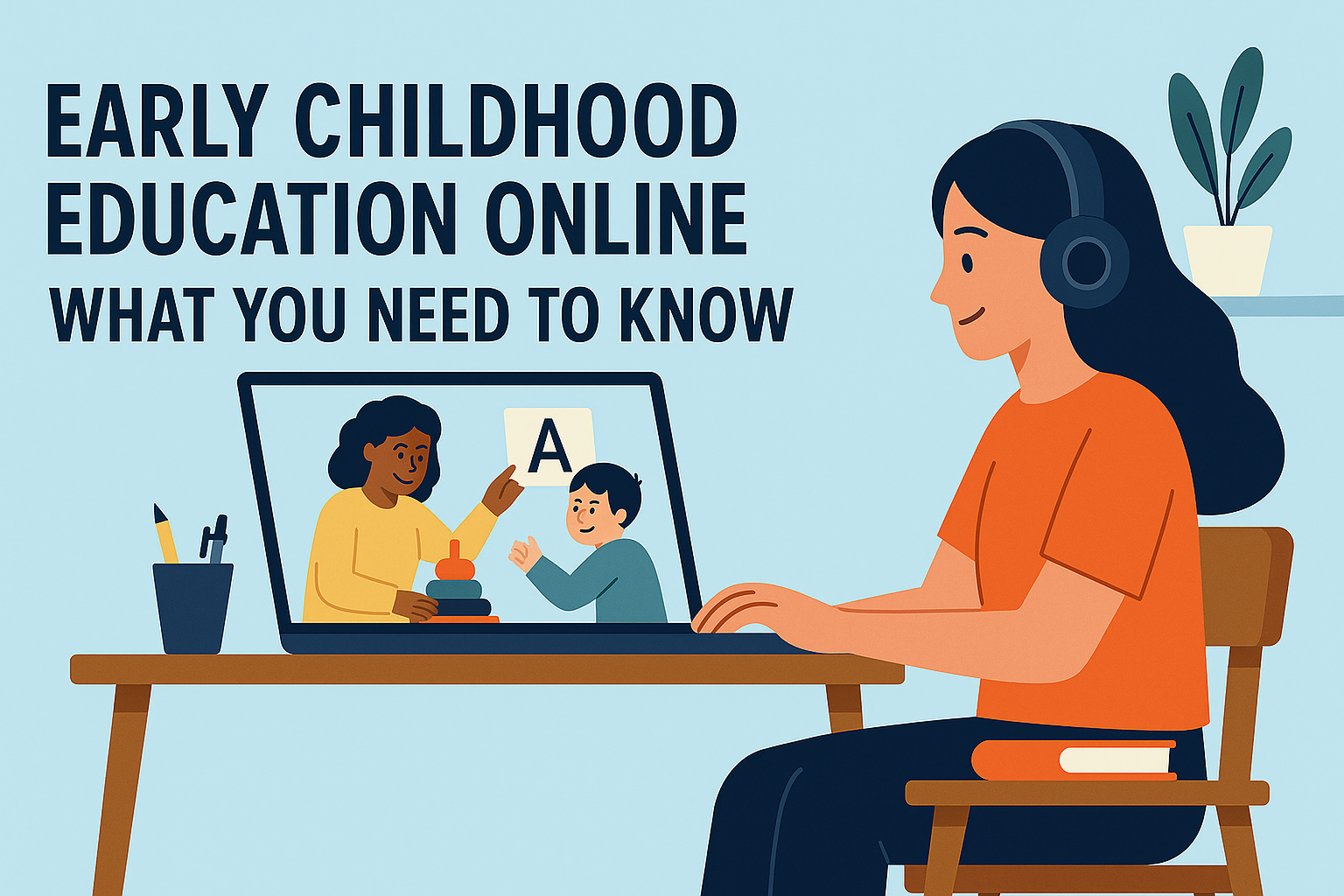Early Childhood Education Online: What You Need to Know

Why Early Childhood Education Online Is Growing Fast. Early childhood education online is now a big part of learning. More parents are choosing digital options for kids aged 3 to 8. This trend grew fast during the pandemic. It continues because it works well for many families. Online early learning gives kids the tools to grow their minds, emotions, and social skills. These programs use videos, games, and live classes. They follow standards like those from NAEYC. Kids learn in fun ways that match how they think and play. This post will cover what online ECE is. We’ll look at its benefits, challenges, and how to choose the right program. We’ll also share teaching tips and the role parents play. By the end, you’ll know if this is the right choice for your child.
What Is Early Childhood Education Online?
Early childhood education online means preschool or kindergarten lessons done through the internet. Kids learn reading, math, art, and social skills using apps, videos, and teacher-led sessions. These programs are made for young learners. They keep lessons short. They mix screen time with hands-on activities. Most require help from adults to guide the child.
Parents can pick full-time virtual schools or add-on programs. Some offer live classes. Others let kids learn at their own pace. The goal is to build a strong start for school and life. All good online ECE programs follow early learning rules. They must be safe, engaging, and age-appropriate. This helps kids grow without stress or confusion.
Benefits of Early Childhood Education Online
Online ECE has clear pluses. Many families find it easier than traditional school. Here are some key reasons to consider it. First, it’s flexible. Kids can learn anytime. This helps working parents or those who travel. Second, it’s accessible. Families in remote areas can get quality programs they couldn’t before.
Third, it’s often cheaper. No commute or daycare costs. Fourth, it’s safer. Kids avoid illness risks from large groups. Fifth, it allows personalization. Some platforms adjust lessons based on each child’s progress.
Here’s a quick list:
- Learn anytime
- Reach top teachers and content
- Match each child’s style
- Stay healthy and safe
- Save money
These benefits make online ECE a smart option for many.
Read more: What You Need to Know About COVID-19 Travel Insurance
Challenges of Early Childhood Education Online
Even though online ECE works well for many, it’s not perfect. There are real issues to think about. One concern is screen time. Young kids should not stare at screens too long. Good programs limit this. They mix video lessons with offline work like drawing or counting blocks. Another issue is social growth. Preschoolers need to play with others. Virtual programs try to fix this. They use group calls and team projects. But it’s not the same as face-to-face time.
Tech access is another barrier. Not all homes have fast internet or devices. Some providers offer printed materials or mobile-friendly apps. Still, this can be hard for low-income families. Teaching online takes special skills. Teachers must keep kids focused through a screen. More training is needed to do this well. These problems are being solved. But parents should know them before starting online ECE.
How to Choose the Right Online ECE Program
Picking the best program matters. A poor choice can lead to wasted time and frustration. Use these points to guide your search. Check for accreditation. Look for programs approved by NAEYC or DEAC. These meet high standards. Make sure lessons fit your child’s age. Three-year-olds need different tools from six-year-olds. Programs should explain what age range they serve.
See what format they use. Do they have live classes? Can you watch later? Decide what fits your schedule. Know how much help you must give. Some programs expect parents to sit with the child. Others let kids work alone more. Ask about support. Do they help with tech issues? Can you talk to the teachers? Will they send updates on your child’s progress? Try a free trial. Many programs offer one. Use it to see if your child likes the style and pace. Use these steps to find a program that works for your family.

Best Ways to Teach Early Childhood Education Online
Teaching little kids online is different. Lessons must be short, fun, and easy to follow. Here’s how to make them work. Use bright visuals. Kids respond to color and movement. Keep slides simple. Add animations or short clips to grab attention. Keep lessons under 20 minutes. After that, switch to drawing, building, or moving. Young minds get tired fast.
Add games. Quizzes, matching cards, and rewards make learning stick. Kids love earning stars or unlocking levels. Talk directly to students. Ask questions. Let them raise hands or type answers. Live chats help build trust and focus. Give offline tasks. Printables, crafts, and counting games balance screen time. These help kids apply what they learn. Send weekly reports. Parents want to know how their child is doing. Use simple charts or notes to show progress. These methods help kids stay engaged and learn well online.
How Parents Help With Online ECE
Parents are key in online learning. Their role changes with the child’s age. Younger kids need more help. Older ones may work alone more. Create a learning space. Use a quiet corner with a chair, table, and supplies. Keep distractions low. Have paper, crayons, and headphones ready.
Set a daily routine. Wake up, eat, learn, play, rest. Structure helps kids feel safe. Stick to the same times each day. Be nearby. Even if the child works alone, stay close. Help with directions or tech issues. Praise effort, not just results. Talk to teachers. Ask how your child is doing. Share concerns. Work together to solve problems. Limit screen time. Balance lessons with outdoor play, books, or music. Don’t let screens take over the day. Your support makes online ECE work better. Kids learn more when parents are involved.
Conclusion: Is Online ECE Right for Your Child?
Early childhood education online is here to stay. It offers flexibility, cost savings, and quality learning. But it’s not for every child or parent. If you have stable internet, time to help, and a child who likes screens, online ECE could be great. If your child needs lots of physical play or gets distracted easily, a traditional class might suit them better.
The best programs are accredited, age-appropriate, and interactive. They blend video lessons with hands-on tasks. They also let parents track progress. As technology grows, online ECE will improve. More schools are adding digital options. Hybrid models—mixing online and in-person—are becoming common. Think carefully. Try a demo. Talk to other parents. Make the choice that fits your family best
Read more: Discover the Best Opportunities with Trade Me Jobs: A Step-by-Step Guide
FAQ: Common Questions About Early Childhood Education Online
Q1: Can my 3-year-old handle online learning?
Yes. Many programs are built for kids as young as 3. They use short lessons, visuals, and adult help. Pick one designed for their age.
Q2: How much screen time is okay?
The AAP says no more than 1 hour a day for kids under 5. Good programs keep lessons short and mix with offline work.
Q3: Will my child miss out on social skills?
Not if the program includes live interaction. Group calls, games, and projects help kids connect. But it’s not the same as real playdates.
Q4: Are online ECE programs expensive?
Some are free. Others cost $50–$200 per month. Prices vary by provider. Public schools sometimes offer free virtual preschool.
Q5: How do I know if my child is learning?
Good programs track progress. They send reports or let you view scores. You can also watch how your child talks, writes, or solves problems.
Q6: Are these programs accredited?
Some are. Check for approval from NAEYC or DEAC. Not all are, so ask before signing up.

